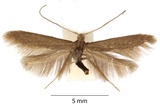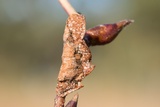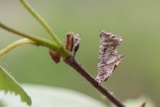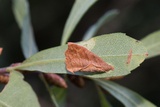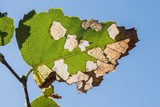Coleophora siccifolia Stainton, 1856 Species
Last modified: Nov. 28, 2025, 1:56 p.m.
A rare species throughout Belgium, mostly found as a case. Most observations are from the western part of the country and in the Kempen, where it is sometimes not rare.
Details
- Classification
- Family: Coleophoridae > Genus: Coleophora > Species: Coleophora siccifolia
- Vernacular names
- Grote bladkokermot (NL), Grey birch case-bearer (EN), Große Sackträgermotte (DE)
- First mention in Belgium
- Coenen F. 1986c. Coleophora siccifolia Stainton, 1856, espèce nouvelle pour la faune belge (Lepidoptera, Coleophoridae). — Linneana belgica 10: 327–330. On page 327.
- Status
-
Native
Distribution
Case
The larva makes a tubular leaf case. The case is almost barrel-shaped, with a large leaf fragment that, while withering, folds itself untidily around the tube. So giving the name "siccifolia" = dryed leave, to this species.
See also bladmineerders.be.
Bionomics
At first the larva makes little mines. After that the larva feeds from a tubular leaf case. The caterpillars are fully grown in October.
Pupation in the case attached to a stem of the food plant, vegetation or tree trunks.
Flight periods
The adults fly in one generation a year in May, June and July.
Observed on
- Host plant (species):
- Sorbus aucuparia
- Host plant (genera):
- Betula, Crataegus, Malus, Alnus, Carpinus, Tilia, Ligustrum and Myrica
- Substrates:
- Deciduous trees and Polyphagous
The larva is very polyphagous. Mostly found on Betula pendula, Crataegus, Malus or Sorbus and many more.
